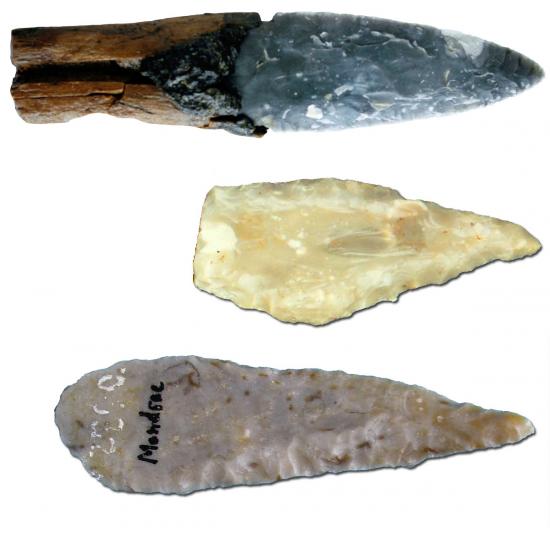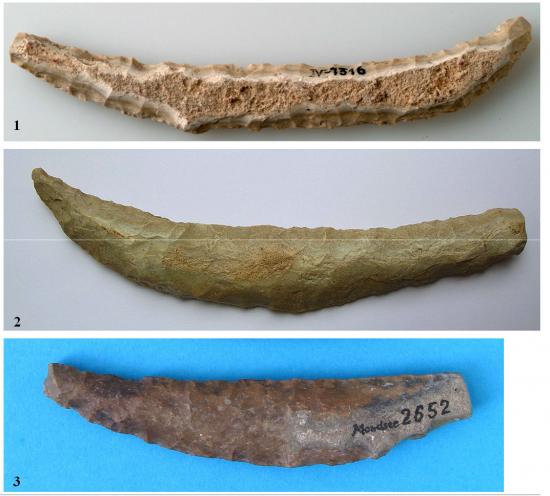Alexander Binsteiner
Source - http://www.pasthorizonspr.com/index.php/archives/02/2014/otzis-flint-one-sided-relationship
More than 20 years have passed since the well preserved mummy of Ötzi was discovered on the Ötztal Alps near the Similaun mountain and Hauslabjochon at the border between Austria and Italy. One of the first studies carried out after the discovery, was to determine the origin of flint tools that “The Iceman” (who lived around 3,300 BCE) was carrying with him when he died, as they promised valuable information to understanding his environment and connections.

Flintmine locations and artefact findspots by source. 1 Arbon; 2 Hornstaad; 3 Allensbach; 4 Federseemoor; 5 Pestenacker; 6 Roseninsel im Starnberger See; 7 Landshut; 8 Eichendorf; 9 Straubing; 10 Fürstenzell; 11 Ansfelden; 12 Engerwitzdorf;13 Laussa; 14 See am Mondsee; 15 Seewalchen; 16 Salzburg; 17 Ainring; 18 Chiemgau; 19 Wasserburg am Inn; (c) Alexander Binsteiner
An Italian connection
The trail led quickly to Monti Lessini, in the province of Verona, Italy. In the limestone strata of the mountain, flint deposits have been mined and then processed from prehistoric times to present day. It has even been shown that Neanderthals knew this area as a rich source of flint.
From the 18th to the mid 19th century flint mining at Lessini underwent a revival, as the deposits were required in large quantities for the gunflints that sparked the guns of European armies.
During the lifetime of Ötzi (European Neolithic/Chalcolithic), Lessini flint was extracted in a number of quarries for the production of an array of tools and weapons, such as long narrow blades, sickle blade inserts, stalked arrowheads and flint daggers.(1)

1 Grey Lessinian flint dagger from Allensbach (16.0 cm). 2 Yellow-brown flint dagger of the Altheim culture in Landshut, Lower Bavaria (length 6.2 cm). 3 Finely retouched blade of Lessini flint from the Arnhofen Flintmine (7.2 cm). © A. Binsteiner
Bavarian archaeological sites
Numerous sites with Lessin flint artefacts were identified in both Upper and Lower Bavaria and often appeared in conjunction with flint tools originating from the more local Baierdorf and Arnhofen chert mines.

Blade and borer from Mondsee using Arnhofen chert. © A. Binsteiner
In the area around the town of Landshut for example, there are several locations with this tool assemblage including the settlement site at Ergolding–Fischergasse(4) and Lessini type flint daggers are found at Altheim.(5) Several more of these daggers were located at Roseninsel in the Starnberger lake, near Straubing, in Eichendorf, Dingolfing-Landau and in Fuerstenzell.(6)
In fact, dozens of sites exhibited the same combination of Lessini artefacts alongside Baierdorf Arnhofen chert tools.(7)
Cultural contexts
The assemblages of flint tools from several flint mine sources in a prehistoric settlement strongly suggests a connection between people from different cultural backgrounds within a region.
The Jurassic cherts from the mines of Baierdorf and Arnhofen were distributed through all phases of the Neolithic in Upper and Lower Bavaria. However, their occurrence is limited geographically to settlements north of the Alps with no known examples of this easily identifiable material found to the south.
However, the appearance of Lessini flints in the pile-dwelling settlements along the northern edge of the Alps shows a direction of movement of people heading south to north during the time that Ötzi lived in the fourth millennium BC.
Varying interpretations
The reasons for this are conjectural at the moment. Were Italian traders exchanging high quality flint including such items as daggers and finely retouched blades in the north? Or do these items perhaps represent the gift giving of copper prospectors in search of new deposits in the Alps, (already being exploited at Mitterberg im Pongau)? If so, they may have come across the lake dwellers of the Mondsee culture during their search.

Sickle blades from the Mondsee Culture. 1 Laussa, Bez. Steyr-Land; Länge: 13,3 cm; 2 Hart, Gem. Langenstein, Bez. Perg; Länge: 11,55 cm. 3 See am Mondsee, Bez. Vöcklabruck; Länge: 9,7 cm. © A. Binsteiner
This interpretation of the existing information could of course be wrong and it may represent Chalcolithic peoples from Northern Italy trying to take the resources by force; these items finding their way into the possession of the lake dwellers during conflict.
Understanding complex societies
The study is opening up new methodologies for understanding the complex societies that are emerging during this period. One clear conclusion is that the contemporaries of Ötzi living in the settlements of South Tyrol and Trentino knew about the cultures beyond the Alps, either directly having undertaken arduous journeys over the mountains themselves, or if not, through stories of the mountaineers who actually had.
A test of physical resilience
Those that did cross the Alps between north and south were not ordinary people. It was a test of physical resilience to cross these high mountains and it is obvious that Ötzi was such a person, and would have been familiar with those who traded valuable Lessini flints in return for a commodity that must have been worth the obvious risks.
Source: © 2014 Alexander Binsteiner
-
1. L. Salzani, Preistoria in Valpolicella. Centro di documentazione per la storia delle Valpolicella. Verona 1981.
-
2 A. Binsteiner, Ausgewählte Silexlagerstätten und deren Abbau in den Provinzen Trient und Verona. Arch. Korrbl. 24, 1994, 255-263.
-
3 K. Spindler, Der Mann im Eis. München 2000, 326-327.
-
4 B. S. Ottaway, Ergolding-Fischergasse – Eine Feuchtbodensiedlung der Altheimer Kultur in Niederbayern. Materialh. Bayer. Vorgesch. 68, Kallmünz 1995, 130-132.
-
5 Dazu: A. Binsteiner, Materialinterferenzen im Verbreitungsgebiet bayerischer Jurahornsteine in Mittel- und Osteuropa. Arch. Korrbl. 34, 2004, 171; zuletzt: Ders., Drehscheibe Linz – Steinzeithandel an der Donau. Linzer Arch Forsch 37, Linz 2006, 56, Abb. 22.
-
6 Dazu Anm. 5. Linzer Arch Forsch 37, Linz 2006, 57, Abb. 23.
-
7 D. Underwood, The research potential of chert industries from the later neolithic wetland settlements of the alpine foreland: a case study from Pestenacker Germany. In: M.A. Bustillo/A. Ramos-Millan (Hrsg.), VI. Internat. Flint Symposium Abstracts (Madrid, Bilbao, Granada 1991) 277-280. – Ders., Silexmaterial aus der jungneolithischen Feuchtbodensiedlung Pestenacker, Oberbayern und Umgebung. Dissertation, Frankfurt a. Main 2004.